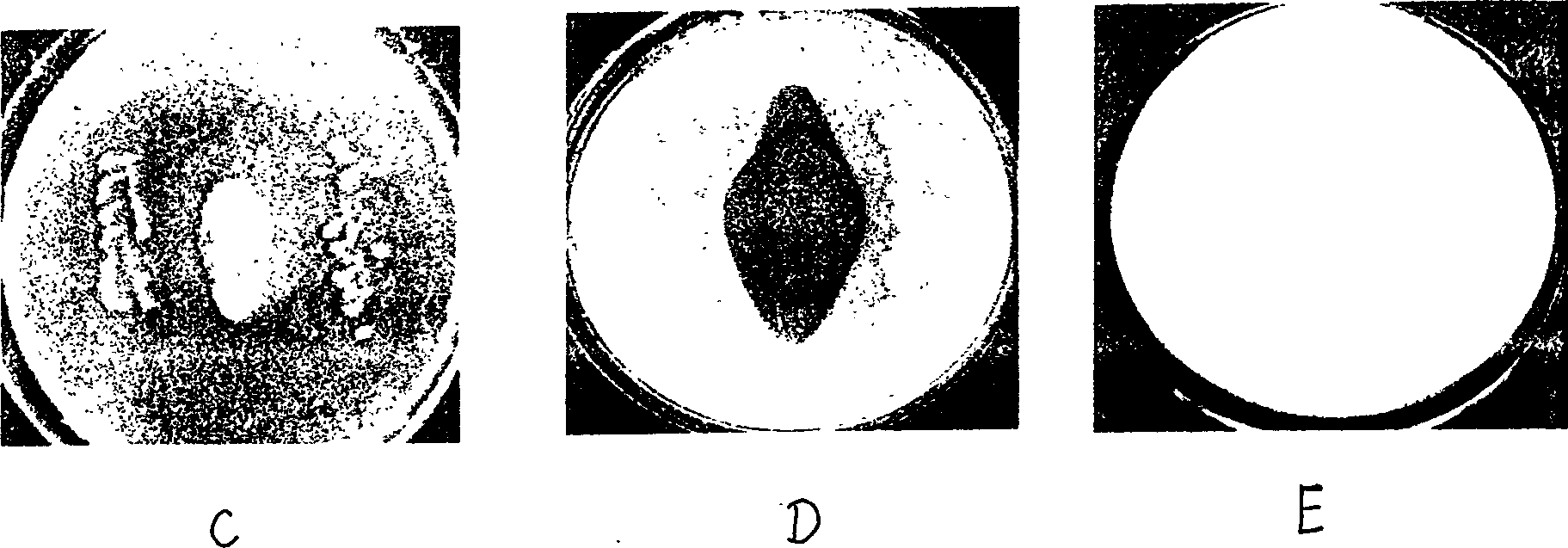Strain of streptomycete for preventing sheath blight of rice
A technology for rice sheath blight and rice blast, which can be applied in the directions of bacteria, botanical equipment and methods, and microbial determination/inspection, and can solve human health and environmental hazards, limited genetic engineering, and lack of high sheath blight resistance genes. and other problems, to achieve the effect of solving pests and diseases, strong antagonism and good control effect
- Summary
- Abstract
- Description
- Claims
- Application Information
AI Technical Summary
Problems solved by technology
Method used
Image
Examples
Embodiment 1
[0038] Embodiment 1: the screening method of H50 bacterial strain
[0039] Pick an appropriate amount of soil collected from various test sites in Wenjiang, Sichuan, and place it in a 250ml Erlenmeyer flask filled with sterile water, and cultivate it at 120 rpm at 25°C for 12 hours, then draw 1ml of the bacterial solution, and use Concentration gradient method is applied to PDA plates (200 grams of potatoes, 10-20 grams of sucrose, 17-20 grams of agar, 1000 ml of water), and cultured in a constant temperature incubator at 26-28 °C. After 48 hours, single colonies with different culture characteristics were picked and purified repeatedly for testing. First use the dot connection method for primary selection, and then use the plate confrontation culture method for the strains that have inhibition zones against rice sheath blight and rice blast pathogens.
Embodiment 2
[0040] Embodiment 2: Antibiotic research of antagonistic bacteria
[0041] A. Determination of the antibacterial rate of antagonistic bacteria on sheath blight bacteria and rice blast pathogens: put the mycelia blocks of the same age in the bacterial fermentation broth passed through the microporous membrane and soak for 5 minutes, and then place them on PDA and YPTG by spot connection method Cultivate on the plate at 28°C, control with clean water, and calculate the antibacterial rate.
[0042] By measuring the growth of the sheath blight mycelia block containing the supernatant of the antagonistic substances collected after shaking culture in the PAD liquid medium, the bacteriostatic rate of the H50 strain was 67.3%; on the YPTG medium, The antibacterial rate of H50 strain reached 62.5%.
[0043] B. Determination of the teratogenic effect of antagonistic bacteria on sheath blight mycelia and rice blast: the antagonistic bacteria are inoculated with the confrontation method,...
Embodiment 3
[0050] Embodiment 3: Identification of bacterial strain
[0051] A. Morphological characteristics: After culturing on peptone medium and beef extract agar at 30°C for 2 to 4 days, observe the morphology of bacteria with electron microscope and optical microscope and take pictures.
[0052] B. Culture characteristics: Gaoshi Synthetic Agar No. 1, Glucose Aspartate Agar, Sucrose Nitrate Agar, Starch Ammonium Salt Agar, Inorganic Salt Starch Agar Yeast Refined Malt Agar, Oat Flour Agar, Potato Extract Agar Medium 30℃ After 2 to 4 days of culture, observe the colony shape and cell color.
[0053] C. Chemical classification: analysis of chemical components of cell wall The analysis of amino acids and glycoforms of the whole cell hydrolyzate was carried out by fast thin-plate chromatography (TCL) improved by Hasegawa.
[0054] D. Physiological and biochemical experiments: Refer to the content of "Bergeys Manual of Sustematic Bacteriology" VO1.II to conduct physiological and biochem...
PUM
 Login to View More
Login to View More Abstract
Description
Claims
Application Information
 Login to View More
Login to View More - R&D
- Intellectual Property
- Life Sciences
- Materials
- Tech Scout
- Unparalleled Data Quality
- Higher Quality Content
- 60% Fewer Hallucinations
Browse by: Latest US Patents, China's latest patents, Technical Efficacy Thesaurus, Application Domain, Technology Topic, Popular Technical Reports.
© 2025 PatSnap. All rights reserved.Legal|Privacy policy|Modern Slavery Act Transparency Statement|Sitemap|About US| Contact US: help@patsnap.com



